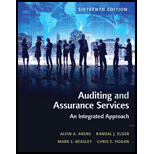
Auditing and Assurance Services, Student Value Edition (16th Edition)
16th Edition
ISBN: 9780134075754
Author: Alvin A. Arens, Randal J. Elder, Mark S. Beasley, Chris E. Hogan
Publisher: PEARSON
expand_more
expand_more
format_list_bulleted
Question
Chapter 15, Problem 16RQ
To determine
Identify the factors that auditors use to decide appropriate ARO and comparison of
Expert Solution & Answer
Want to see the full answer?
Check out a sample textbook solution
Students have asked these similar questions
Skyline Enterprises' CVP income statement includes
sales of 5,500 units, a selling price of $120 per unit,
variable expenses of $75 per unit, and fixed expenses
of $140,000. What is the net income?
a. $82,500
b. $125,000
c. $107,500
d. $75,000
Financial Accounting
Compute the rate of return on average common shareholders equity
Chapter 15 Solutions
Auditing and Assurance Services, Student Value Edition (16th Edition)
Ch. 15 - Prob. 1RQCh. 15 - Prob. 2RQCh. 15 - Prob. 3RQCh. 15 - Prob. 4RQCh. 15 - Prob. 5RQCh. 15 - Prob. 6RQCh. 15 - Prob. 7RQCh. 15 - Prob. 8RQCh. 15 - Prob. 9RQCh. 15 - Prob. 10RQ
Ch. 15 - Prob. 11RQCh. 15 - Prob. 12RQCh. 15 - Prob. 13RQCh. 15 - Distinguish between the TER and the CUER. How is...Ch. 15 - Prob. 15RQCh. 15 - Prob. 16RQCh. 15 - Prob. 17RQCh. 15 - Prob. 18RQCh. 15 - Prob. 19RQCh. 15 - Prob. 20RQCh. 15 - Prob. 21RQCh. 15 - Prob. 22.1MCQCh. 15 - Prob. 22.2MCQCh. 15 - Prob. 22.3MCQCh. 15 - Prob. 23.1MCQCh. 15 - Prob. 23.2MCQCh. 15 - Prob. 23.3MCQCh. 15 - Prob. 24.1MCQCh. 15 - Prob. 24.2MCQCh. 15 - Prob. 24.3MCQCh. 15 - Prob. 25.1MCQCh. 15 - Prob. 25.2MCQCh. 15 - Prob. 25.3MCQCh. 15 - Prob. 27DQPCh. 15 - Lenter Supply Company is a medium-sized...Ch. 15 - Prob. 29DQPCh. 15 - Prob. 30DQPCh. 15 - Prob. 31DQPCh. 15 - Prob. 32DQPCh. 15 - Prob. 33DQPCh. 15 - Prob. 34DQPCh. 15 - Prob. 35DQPCh. 15 - Prob. 36CCh. 15 - Prob. 37ICA
Knowledge Booster
Similar questions
- During 20x2 Creswell Corporation sold $5,500 of inventory on credit. The company's beginning and ending accounts receivable balances were $30,000 and $32,500, respectively. How much cash did Creswell Corporation collect on the account? If the ending accounts receivable had been $27,000, how much cash would Creswell Corporation have collected?arrow_forwardHow much cash was collected from customers during 2023 on these general accounting question?arrow_forwardCompute the missing amountarrow_forward
arrow_back_ios
SEE MORE QUESTIONS
arrow_forward_ios
Recommended textbooks for you
 Auditing: A Risk Based-Approach (MindTap Course L...AccountingISBN:9781337619455Author:Karla M Johnstone, Audrey A. Gramling, Larry E. RittenbergPublisher:Cengage Learning
Auditing: A Risk Based-Approach (MindTap Course L...AccountingISBN:9781337619455Author:Karla M Johnstone, Audrey A. Gramling, Larry E. RittenbergPublisher:Cengage Learning Essentials of Business Analytics (MindTap Course ...StatisticsISBN:9781305627734Author:Jeffrey D. Camm, James J. Cochran, Michael J. Fry, Jeffrey W. Ohlmann, David R. AndersonPublisher:Cengage Learning
Essentials of Business Analytics (MindTap Course ...StatisticsISBN:9781305627734Author:Jeffrey D. Camm, James J. Cochran, Michael J. Fry, Jeffrey W. Ohlmann, David R. AndersonPublisher:Cengage Learning

Auditing: A Risk Based-Approach (MindTap Course L...
Accounting
ISBN:9781337619455
Author:Karla M Johnstone, Audrey A. Gramling, Larry E. Rittenberg
Publisher:Cengage Learning

Essentials of Business Analytics (MindTap Course ...
Statistics
ISBN:9781305627734
Author:Jeffrey D. Camm, James J. Cochran, Michael J. Fry, Jeffrey W. Ohlmann, David R. Anderson
Publisher:Cengage Learning